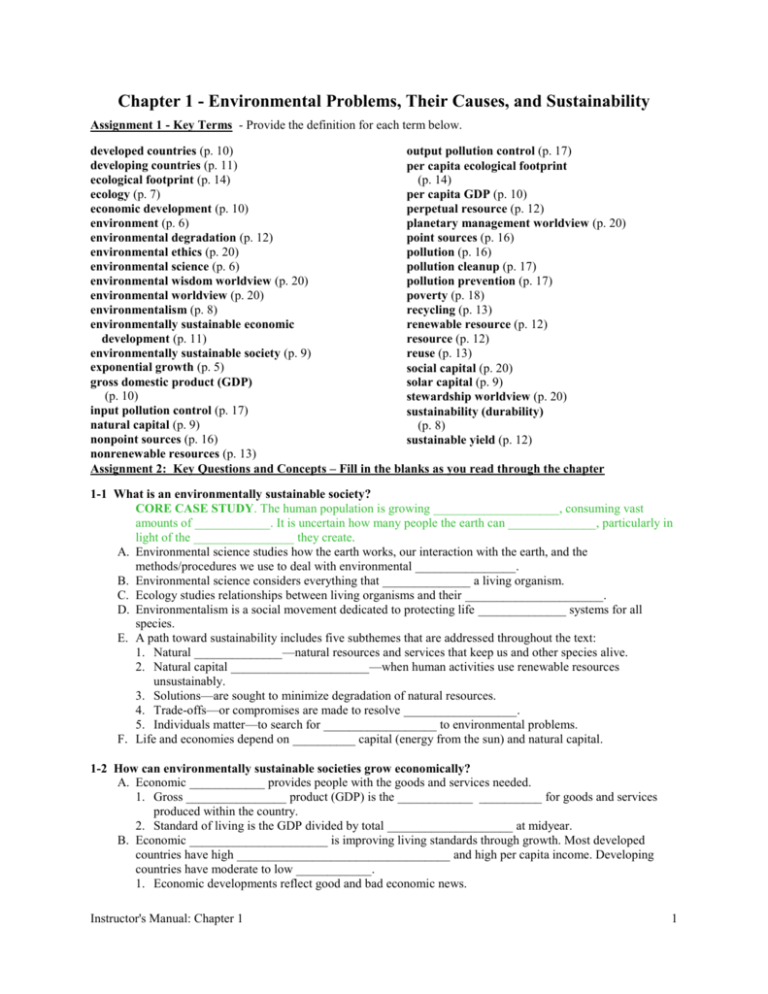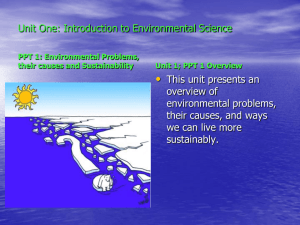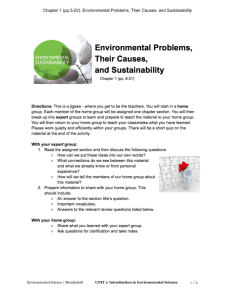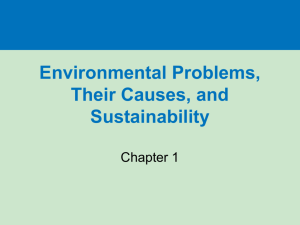Ch1 Vocab & Study Guide ch1studyguide
advertisement

Chapter 1 - Environmental Problems, Their Causes, and Sustainability Assignment 1 - Key Terms - Provide the definition for each term below. developed countries (p. 10) output pollution control (p. 17) developing countries (p. 11) per capita ecological footprint ecological footprint (p. 14) (p. 14) ecology (p. 7) per capita GDP (p. 10) economic development (p. 10) perpetual resource (p. 12) environment (p. 6) planetary management worldview (p. 20) environmental degradation (p. 12) point sources (p. 16) environmental ethics (p. 20) pollution (p. 16) environmental science (p. 6) pollution cleanup (p. 17) environmental wisdom worldview (p. 20) pollution prevention (p. 17) environmental worldview (p. 20) poverty (p. 18) environmentalism (p. 8) recycling (p. 13) renewable resource (p. 12) environmentally sustainable economic development (p. 11) resource (p. 12) environmentally sustainable society (p. 9) reuse (p. 13) exponential growth (p. 5) social capital (p. 20) gross domestic product (GDP) solar capital (p. 9) (p. 10) stewardship worldview (p. 20) input pollution control (p. 17) sustainability (durability) natural capital (p. 9) (p. 8) nonpoint sources (p. 16) sustainable yield (p. 12) nonrenewable resources (p. 13) Assignment 2: Key Questions and Concepts – Fill in the blanks as you read through the chapter 1-1 What is an environmentally sustainable society? CORE CASE STUDY. The human population is growing ____________________, consuming vast amounts of ____________. It is uncertain how many people the earth can ______________, particularly in light of the ________________ they create. A. Environmental science studies how the earth works, our interaction with the earth, and the methods/procedures we use to deal with environmental ________________. B. Environmental science considers everything that ______________ a living organism. C. Ecology studies relationships between living organisms and their ______________________. D. Environmentalism is a social movement dedicated to protecting life ______________ systems for all species. E. A path toward sustainability includes five subthemes that are addressed throughout the text: 1. Natural ______________—natural resources and services that keep us and other species alive. 2. Natural capital ______________________—when human activities use renewable resources unsustainably. 3. Solutions—are sought to minimize degradation of natural resources. 4. Trade-offs—or compromises are made to resolve __________________. 5. Individuals matter—to search for __________________ to environmental problems. F. Life and economies depend on __________ capital (energy from the sun) and natural capital. 1-2 How can environmentally sustainable societies grow economically? A. Economic ____________ provides people with the goods and services needed. 1. Gross ________________ product (GDP) is the ____________ __________ for goods and services produced within the country. 2. Standard of living is the GDP divided by total ____________________ at midyear. B. Economic ______________________ is improving living standards through growth. Most developed countries have high __________________________________ and high per capita income. Developing countries have moderate to low ____________. 1. Economic developments reflect good and bad economic news. Instructor's Manual: Chapter 1 1 a. Poverty produces ______________ environmental effects. 2. Developed countries enjoy a higher standard of living. a. Longer life ____________________. b. Decrease in infant __________________. 3. Environmentally sustainable development ______________ sustainable activities and ______________________ harmful activities. 1-3 How are our ecological footprints affecting the earth? A. Natural capital/natural ________________ are those in the environment or those obtained from the environment: food, __________, air, shelter petroleum, etc. B. Material resources we get from the environment are classified as __________________, renewable, or nonrenewable. 1. A perpetual resource is renewed ________________________, like solar energy. 2. Sustainable __________ is the highest rate of use on an indefinite scale without degradation or __________________. 3. Environmental degradation occurs when use of resources exceeds rate of ______________________. C. The Tragedy of the _______________ describes the overuse or degradation of freely __________________ resources such as ocean pollution, abuse of national parks, air pollution, etc. No one individual owns these ________-access resources. D. What is our ecological __________________, our impact on the environment? 1. The per ____________ ecological footprint is the biologically productive land and water needed to supply renewable resources and absorb waste for each ___________________. 2. Humanity’s ecological footprint ______________ by about 39% the earth’s ecological capacity (or biocapacity) to __________________ its renewable resources and absorb the resulting __________ products and pollution. E. What are nonrenewable resources? 1. Nonrenewable resources are those that exist in __________ quantity or stock in the earth’s crust. The resource is economically depleted when it __________ too much to obtain what is left. 2. These resources include ____________ resources (oil, coal, natural gas), metallic mineral resources (copper, iron, aluminum, etc.), and nonmetallic ________________ like salt, clay, sand, and phosphates. 3. There are solutions for an economically depleted resource. a. Try to find ________ of the resource. b. Recycle the resource. c. Waste ________. d. ______ less. e. Try to develop a __________________ for the resource. CASE STUDY: The number of affluent __________________ will soon double, as people in underdeveloped countries attain a ______________________ lifestyle. China is already a leading consumer of many resources, and its economy and population are continuing to ________ at a rapid rate. Thus, its ecological footprint and overall level of ________________ consumption are expected to continue to grow. 1-4 What is pollution and what can we do about it? A. Pollutants are chemicals at high enough levels in the environment to ________ people or other living organisms. 1. Pollutants may enter the environment naturally (e.g., volcanic eruptions) or through __________ activities. 2. Point sources of pollutants are _____________, identifiable sources. 3. Non-point sources are __________________. 4. Three unwanted effects of pollutants are: a. They can ______________ or degrade life-support systems of any organism. b. They damage human ____________, wildlife, and property c. They can produce __________________ in the form of noise, smells, tastes, and sights. B. Solutions: What can we do about pollution? 1. We use two basic approaches to deal with pollution. 2 Environmental Problems, Their Causes, and Sustainability a. Pollution prevention/input pollution control reduces or eliminates ____________________ of pollutants. b. Pollution cleanup/output pollution control cleans up or ______________ pollutants after they have been produced. c. Problems with pollution clean up include: 1) __________________ bandage without long-term pollution control technology, like the catalytic converter. 2) Pollutant is removed but causes pollution in another __________: burning garbage/burying it. 3) __________________ to reduce pollution to an acceptable level. Prevention is less expensive. 1-5 Why do we have environmental problems? A. Five major causes of environmental problems are: 1. Population ____________. 2. Wasteful Resource ______. 3. Poverty. 4. Poor environmental accounting. 5. Ecological __________________. B. Affluence is the addiction to over-consumption of material goods. 1. Symptoms: high debt level, declining health, increased stress, more bankruptcies. 2. Solutions: admit the problem, shop less, avoid malls and other shopping addicts. 3. Toynbee’s law of progressive simplification: transfer energy and attention to the nonmaterial side of life. C. Affluence of developed countries can lead to environmental improvements. 1. Money is available for technological improvements. 2. Since 1970, air and water are ______________ than previously. 3. Money was __________ on environmental improvements. D. Environmental worldviews and ethics determine the way people view the seriousness of environmental problems. 1. Your environmental worldview is your assumptions and values about the world and your role. a. The planetary management worldview holds that nature exists to meet ______ needs. b. The stewardship worldview holds that we mange the earth, but we have an ______________ responsibility to be stewards of the earth. c. The environmental wisdom worldview holds that we are connected to nature and that nature exists for all ______________ equally. CASE STUDY: Chattanooga, Tennessee, was once one of the most polluted cities in the United States. In the mid-1980s civic leaders gathered together community members to identify problems and brainstorm __________________. After years of encouraging ________-emission industries, implementing recycling programs, and renovating much of the city, Chattanooga is an example of what can be accomplished when cities build their ____________ capital. 1-6 What are four scientific principles of sustainability? A. There are four major components of earth’s natural sustainability 1. Reliance on __________ energy. 2. Reserve _________________________. 3. Population ______________. 4. _________________ recycling. Environmental Issues, Their Causes, and Sustainability 3








